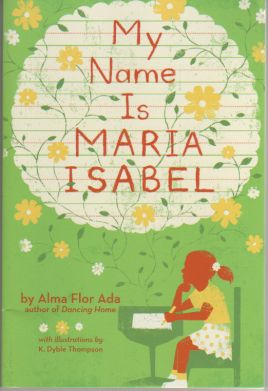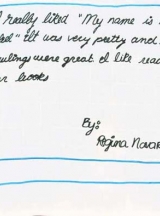My Name is María Isabel
Me llamo María Isabel
Book Description
María Isabel, a Hispanic child growing up in the U.S., begins having problems in her new classroom when her teacher changes her name to Mary. This compelling portrait of an experience common to many language minority children inspires discussions on self-identity and biculturalism. “Captures the authentic flavor of Latino culture in this warm, yet never sentimental, story: an entire family genealogy is encapsulated in a Latino name, as well as special connections between its bearer and the relatives for whom she was named. Presented in realistic terms, María Isabel’s struggles will ring true to many children in the US. Pair this with Barbara Cohen’s Molly’s Pilgrim for a fine multicultural comparison.” (THE KIRKUS REVIEW).
Reviews
Publishers Weekly
Armed with her new blue bookbag, Maria Isabel bravely faces her first day at a new school. But when she meets her new teacher, she is told there are already two other Marias in the class. “Why don’t we call you Mary instead?” her teacher suggests, unaware that Maria was named for both her grandmothers, a grandfather and her father. Maria’s inability to respond to “Mary” leads to more problems. Simply told, this story combines the struggle of a Puerto Rican family’s efforts to improve their life with a shared sense of pride in their heritage. The author’s carefully drawn characterizations avoid stereotypes, thus increasing their appeal and believability. An essay involving a wish list gives Maria a chance to reclaim her name, and allows her teacher to make amends. Abetted by Thompson’s straightforward black-and-white drawings, this contemporary tale serves as a good reminder that no two names are really alike. Ages 7-10.
School Library Journal
Grade 3-4: This gentle story tells of Maria Isabel Salazar Lopez, who finds herself dubbed “Mary Lopez” when her family moves and she is placed in a class with two other Marias. Maria Isabel finds it hard to respond to a name that does not seem like hers. Her teacher doesn’t understand why it is so difficult for her to answer to “Mary” until the child is inspired to address her paper on “My Greatest Wish” to the topic of her name. The result is not only a happy ending, but also an affirming study of heritage and how it is integrally bound up in an individual’s sense of self. The brief text, adequately extended by line drawings, reads aloud well and could certainly be used in conjunction with Gary Soto’s The Skirt (Delacorte, 1992) to illustrate the Hispanic culture that is part of the lives of many contemporary children. –Ann Welton, Terminal Park Elementary School, Auburn, WA
Kirkus Reviews
When María Isabel Salazar López’s family moves, there are already two Marías in her new class, so the teacher decides to call her Mary López. Since she doesn’t readily recognize this new name, María Isabel is continually scolded for being inattentive; worse, her pride in being named for her grandmothers is dishonored. María Isabel’s reluctance to assert her wish to be called by her full name involves her in an apparent web of deception when she doesn’t get a part in a pageant (she doesn’t recognize her name when the teacher is assigning roles) but lets her parents believe she’ll participate. Fortunately, an essay assignment provides a solution: she finds the courage to write that her “greatest wish is to be called María Isabel Salazar López,” clearly explaining her reasons; and her teacher responds generously to her plea. Cuban author Ada (The Gold Coin, 1991) captures the authentic flavor of Latino culture in this warm, yet never sentimental, story: an entire family genealogy is encapsulated in a Latino name, as well as special connections between its bearer and the relatives for whom she was named. Presented in realistic terms, María Isabel’s struggles will ring true to many children in the US. Pair this with Barbara Cohen’s Molly’s Pilgrim (1983) for a fine multicultural comparison. (Fiction. 7-10)
Citations
Once Upon a Heroine by Alison Cooper-Mullin, page 94, and page 168.
Let’s Hear It for the Girls : 375 Great Books for Readers 2-14 by Erica Bauermeister, page 102, and Index.
The Between the Lions (R) Book for Parents : Everything You Need to Know to Help Your Child Learn to Read by Linda K. Rath, page 166.
The Children’s Literature Lover’s Book of Lists by Joanna Sullivan, page 193.
Cartwheel to the Moon: My Sicilian Childhood by Emanuel Di Pasquale, Back Flap.
Failing At Fairness: How Our Schools Cheat Girls by Myra Sadker, Back Matter.
Lesson Plan
http://readingtokids.org/Books/BookView.php?pag=3&bookID=00000503
READERS’ RESPONSES
Ideas for the use of this book in different areas
Social Justice Literature for the Elementary Classroom
http://2009bookclubblog.blogspot.com
My Name Is Maria Isabel
By: Alma Flor Ada
Reflection:
- This chapter book is about a little girl, Maria Isabel, who has to go through the usual challenges of being a new student. Her biggest problem, however, is to be called Mary Lopez by her teacher instead of the name she was born with and is supremely proud of-Maria Isabel Salazar Sanchez. To her, this name has so much meaning because of her grandparents and feels that it is one of the most important aspects about her. Throughout the book she struggles to find the courage to stand up for the way she feels and to be understood by her teacher.
- I like this book because it highlights the Hispanic culture which allows Latino students to feel empowered but also encourages respect and acceptance of other cultures since they are focused on as well. I also like that the book revolves around the issue of valuing student’s names and cultures and that it helps students and teachers to realize that these are extremely important aspects of a person that should be respected and understood.
- Currently, I am using Maria Isabel for a book club and will use it to teach literacy while integrating social studies, math, art, and issues of social justice. Social studies ideas: studying Puerto Rican people who have made a change in society, learning about Puerto Rico’s relationship with the United States. Literacy ideas: character analysis, reading comprehension strategies, learning of literary elements, persuasive writing, text to self connections, text to text connections. Math ideas: graphing the increase of Maria Isabel’s courage throughout the book. Social justice ideas: exploring their own identities (all of these students are of Hispanic culture), exploring methods of how they can be courageous, learning and exploring other cultures, learning about the importance of their names and culture, exploring and accepting other people’s holidays and traditions, teaching children conflict/resolution/communication strategies Arts ideas: creating a web of problems and how to get out of it and performing Amahl.
- Ways in which it falls in the domains of sje:
- Children of Hispanic culture are encouraged to love and accept themselves.
- Various cultures are represented in the book and encourage acceptance of other’s cultures, traditions, and holidays.
- This book deals with racism and oppression.
- The method in which Maria Isabel stands up for herself is through a courage driven, detailed essay to the teacher describing why her culture is so important and why devaluing her name and culture is like overlooking the biggest part of her. Students will see how these small social movements can easily be done within the classroom community.
- This book doesn’t directly apply to this domain.
- This book can easily connect to the literacy curricular unit but not limited to the subjects that have been mentioned above.
If you have enjoyed reading or sharing this book, I would very much like to hear from you. Please click here to send your comments.



